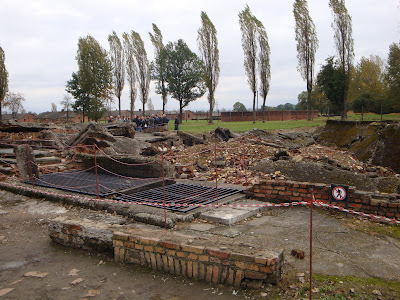




Day 3 - Krakow
On our third day, we went to the concentration camps at Auschwitz-Birkenau. Auschwitz had for a long time been a German name for Oświęcim, the town by and around which the camps were located; the name "Auschwitz" was made the official name again by the Germans after they invaded Poland in September 1939. Birkenau, the German translation of Brzezinka (birch tree), refers to a small Polish village nearby that was mostly destroyed by the Germans to make way for the camp.
From early 1942 until late 1944, transport trains delivered Jews to the camp's gas chambers from all over Nazi-occupied Europe. Others deported to Auschwitz included 150,000 Poles, 23,000 Roma and Sinti, 15,000 Soviet prisoners of war, some 400 Jehovah's Witnesses and tens of thousands of people of diverse nationalities. Approximately, 1.5 million people died at the camps. Those not killed in the gas chambers died of starvation, forced labor, infectious disease, individual executions, and medical experiments. The victims of the medical experiments were mostly children. Of the estimated 200,000 children brought to the camp, only 600 survived.
On January 27, 1945, Auschwitz was liberated by Soviet troops, a day commemorated around the world as International Holocaust Remembrance Day. In 1947, Poland founded a museum on the site of Auschwitz I and II, which by 2010 had seen 29 million visitors—1,300,000 annually—pass through the iron gates crowned with the infamous motto, Arbeit macht frei ("work makes free").
Although the kids came with us on this tour, they did not receive headsets to listen to the tour. Therefore, while the kids saw only empty buildings and rooms, we heard about the atrocities that went on there. Upon arrival, families were split apart with men going one way, women and children going another way. Doctors made selections to identify those fit for work and those (usually the old and disabled) to be sent to the gas chambers. The gas chambers are enormous. Those going to the gas chambers were told that they were getting a bath for disinfection. They were told to undress and to remember the number on the hook where they placed their clothes. Dying in the gas chamber was horribly painful, with death caused by internal suffocation. After death, the bodies went to a crematorium next door and the ashes used for fertilizer.
Some people taken to the camp were told that they were being taken to a new land start a better life. Some even paid for their own trip. Once there, the Nazis took their belongings, shaved their heads (the hair was sent to factories to make clothes and blankets), and put them to work in the camps. Prisoners did not have access to water and their clothes were never cleaned. They did not get enough to eat and often died of starvation. Many prisoners worked outside the camps in coal mines, factories, etc. These people had the best opportunity to escape. However, if they did, their family and/or neighbors would be rounded up and executed on the spot. Poland is the only country during Nazi occupation in which the death penalty was in place and enforced for anyone caught helping a Jew.





The facilities at Auschwitz were brick buildings. These were the old barracks for the Polish military. The facilities at Berkinau were essentially wooden stables. Each stable could reasonably accommodate maybe a few hundred people, but was used in actuality to house thousands of people. 15 to 18 people were crammed into three level bunk beds that looked like they were capable of accommodating only six. The beds were lined with only hay and often times no blankets were provided. Although there were furnaces in the stables, no wood was provided for heating. People often froze to death. The weaker ones were attacked by rats in the middle of the night. The toilet building was a separate stable that consisted simply of two rows of benches with holes cuts into them to make toilets. Prisoners were allowed to use the toilet only once in the morning and once in the night and they had no access to water, so disease was prevalent.
The visit to the camps was one of the most psychologically painful experiences I have ever gone through. The stories behind what I saw will haunt me for the rest of my life. At the end of the tour, the guide said that the camps were made by men to be hell on earth for other men. We have to be aware and take responsibility to make sure it does not happen again.
Many of the Poles that were brought to the camps were academics, doctors, politicians, etc. Polish military that stood up to the Nazis were also taken to the camps. Based on what I have read and seen, the Polish people are amongst the bravest that I know. The visit to the camps helped me to realize what a privilege and an honor it is to be Polish.
We left the camps and took a bus back to the city center. On our first day in Krakow, we noticed a traditional Polish restaurant that was packed with people lining up to get in. We decided to give it a try on this particular day and managed to get a seat. The food was great, but it was a restaurant that catered to students, so the ambience was not the best for families. We ate our meal, picked up dessert at a local bakery and retired for the night.




